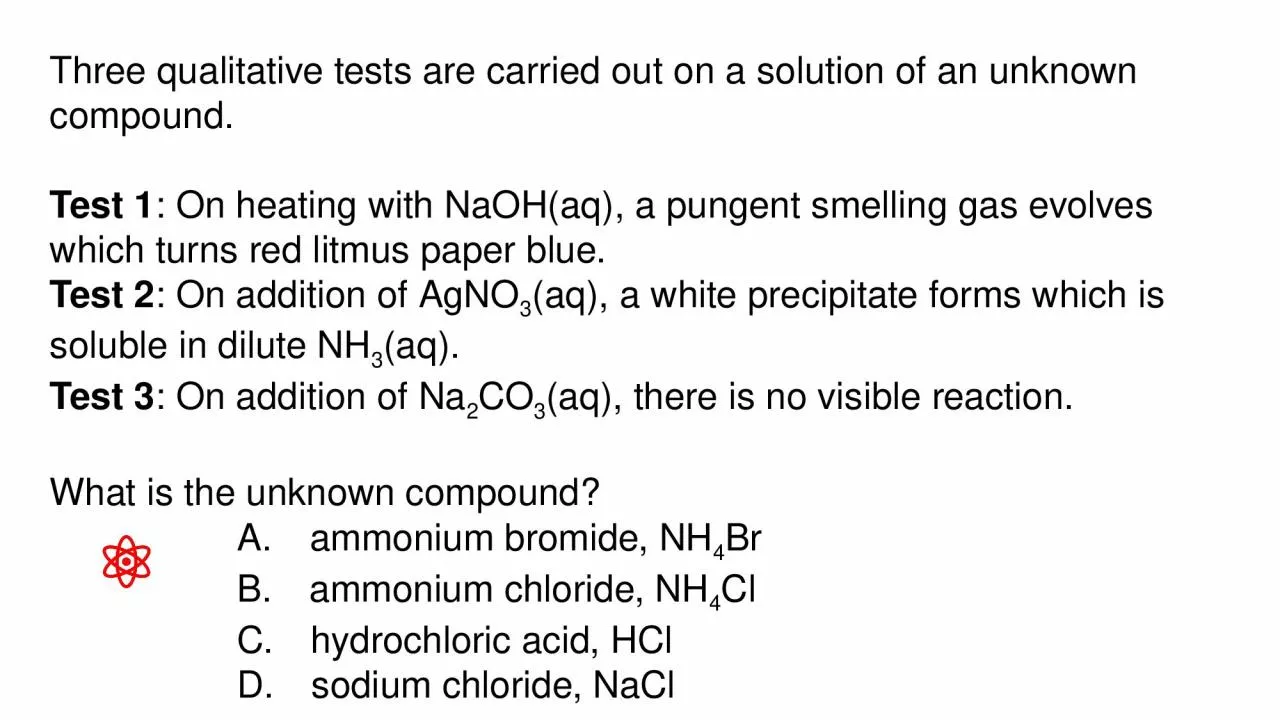

Test 1 On heating with NaOH aq a pungent smelling gas evolves which turns red litmus paper blue Test 2 On addition of AgNO 3 aq a white precipitate forms which is soluble in dilute NH ID: 930190
Download Presentation The PPT/PDF document "Three qualitative tests are carried out ..." is the property of its rightful owner. Permission is granted to download and print the materials on this web site for personal, non-commercial use only, and to display it on your personal computer provided you do not modify the materials and that you retain all copyright notices contained in the materials. By downloading content from our website, you accept the terms of this agreement.
Slide1
Three qualitative tests are carried out on a solution of an unknown compound.Test 1: On heating with NaOH(aq), a pungent smelling gas evolves which turns red litmus paper blue.Test 2: On addition of AgNO3(aq), a white precipitate forms which is soluble in dilute NH3(aq).Test 3: On addition of Na2CO3(aq), there is no visible reaction.What is the unknown compound? ammonium bromide, NH4Br ammonium chloride, NH4Cl hydrochloric acid, HCl sodium chloride, NaCl
Slide2Haloalkanes can undergo hydrolysis.A student carries out an experiment to find the relative rate of hydrolysis of 1-chloropropane, C3H7Cl, 1-bromopropane, C3H7Br, and 1-iodopropane, C3H7I.The student adds 2 cm3 of ethanol to 2 cm3 of aqueous silver nitrate to three test tubes labelled A, B and C.The student adds 5 drops of a different haloalkane to each test-tube in rapid succession and shakes each tube. The student measures the time for a precipitate to form in each test-tube.
Test tube
Haloalkane
Time taken for reaction to take placeAC3H7Clabout half an hourBC3H7Bra few minutesCC3H7Ia few seconds
Write an ionic equation involving aqueous silver nitrate for formation of one of the precipitates.
Ag
+
+ Br
−
→
AgBr
Slide3Haloalkanes can undergo hydrolysis.A student carries out an experiment to find the relative rate of hydrolysis of 1-chloropropane, C3H7Cl, 1-bromopropane, C3H7Br, and 1-iodopropane, C3H7I.The student adds 2 cm3 of ethanol to 2 cm3 of aqueous silver nitrate to three test tubes labelled A, B and C.The student adds 5 drops of a different haloalkane to each test-tube in rapid succession and shakes each tube. The student measures the time for a precipitate to form in each test-tube.Test tube
Haloalkane
Time taken for reaction to take place
AC3H7Clabout half an hourBC3H7Bra few minutesCC3H7Ia few seconds
What do the experimental results tell you about the carbon–halogen bond enthalpies?
Bond enthalpy decreases
C−Cl > C−Br > C−I
Slide4Haloalkanes can undergo hydrolysis.A student carries out an experiment to find the relative rate of hydrolysis of 1-chloropropane, C3H7Cl, 1-bromopropane, C3H7Br, and 1-iodopropane, C3H7I.The student adds 2 cm3 of ethanol to 2 cm3 of aqueous silver nitrate to three test tubes labelled A, B and C.The student adds 5 drops of a different haloalkane to each test-tube in rapid succession and shakes each tube. The student measures the time for a precipitate to form in each test-tube.Test tube
Haloalkane
Time taken for reaction to take place
AC3H7Clabout half an hourBC3H7Bra few minutesCC3H7Ia few seconds
How could the student modify their experiment so that it could be completed in less time?
Heat the test tubes
in a water bath.
Slide5Students work together in groups to identify four different solutions.Each solution contains one of the following compounds:ammonium sulfate, (NH4)2SO4 sodium sulfate, Na2SO4sodium chloride, NaCl potassium bromide, KBr.Your group has been provided with universal indicator paper and the following test reagents:barium chloride solution silver nitrate solutiondilute ammonia solution sodium hydroxide solution. A student in your group suggests the following plan:Add about 1 cm depth of each solution into separate test-tubes.Add a few drops of barium chloride solution to each test-tube.A white precipitate will show which solutions contain sulfate ions.Two of the solutions will form a white precipitate.Describe how you would expand this plan so that all four solutions could be identified using a positive test result. You should provide observations and conclusions that would enable your group to identify all four solutions. [6]To identify sulfates:Ammonium ion test: on the sulfates already identified; warm with NaOH(aq) followed by
Universal indicator test: use of moist indicator paper on (ammonia) gas; correct observation (alkaline gas / high pH / blue or purple) for identification of (NH
4
)2SO4, and by default of Na2SO4.To identify halides:Halide ion test: addition of silver nitrate solution to remaining two solutions; correct observation (white precipitate / cream precipitate)followed bySolubility of precipitate: addition of dilute ammonia solution to halide precipitates; correct observation (silver chloride dissolves) enabling identification of NaCl and by default of KBr.
Slide6A student adds aqueous sodium carbonate to one test-tube and aqueous silver nitrate to a second test-tube.The student adds dilute sulfuric acid to each test‐tube.Which row has the correct observations?Acid + carbonate = effervescence (bubbles)Silver + sulfate gives a false positive – silver sulfate
Slide7Precipitation reactions can be used to distinguish between halide ions.State the reagent needed for these precipitation reactions. [1]How would the appearance of the precipitates allow you to distinguish between chloride, bromide and iodide ions?Chloride ............................................................................................................................Bromide ...................................................................................................................................Iodide ...................................................................................................................................Chloride: white (precipitate)AND Bromide: cream (precipitate)AND iodide: yellow (precipitate) ✓Silver nitrate OR AgNO3 ✓